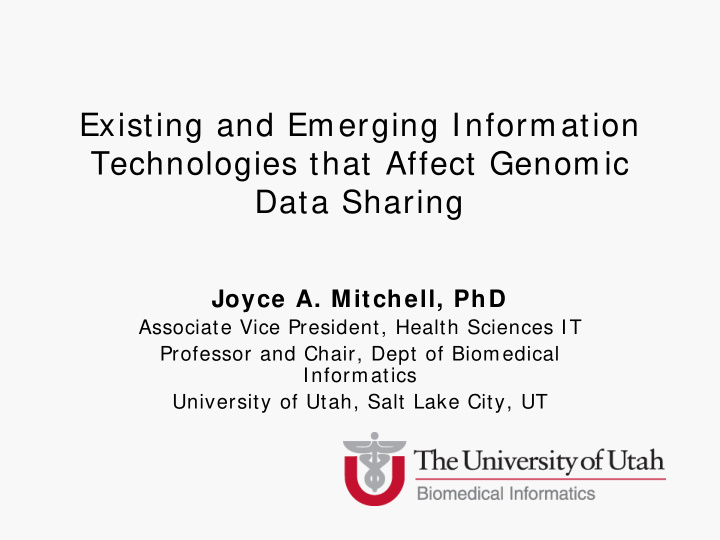



Existing and Emerging Information Technologies that Affect Genomic Data Sharing Joyce A. Mitchell, PhD Associate Vice President, Health Sciences IT Professor and Chair, Dept of Biomedical Informatics University of Utah, Salt Lake City, UT
Genomics • You know a lot about Genomics – Human Genome Project complete in 2003 � 25,000 genes, perhaps 1,000,000 proteins – HapMap completed in 2005 � More than 1 million SNPs – Now over 5000 genomes available online – Incredible information is available online � Public data repositories are routine 2
Genomics (cont) – Almost 1900 specific genetic tests available – 1 million SNP chip studies are routine – GWAS studies are rapidly expanding knowledge (looking for G2P associations) – Gene expression studies are impacting clinical care � Gene function can be measured and used diagnostically – Next Generation Sequencing has arrived. � Avg variant file for a complete human sequence is 3.1 – 4.5 M SNPs, and about 10% more for INDELs, etc. Science 2009. 19892942 3
Consumer Demand for Genetics Information is Exploding!
What is the GHR? http: / / ghr.nlm.nih.gov/ • An information system focusing on the health implications of research arising from the Human Genome Project – Targets the public – Bridges consumer health information and bioinformatics data – Links to existing resources (NLM and other) 5
6
Genetics Home Reference statistics • 500 health conditions • 700 curated + 1800 auto- generated gene summaries • 215 million hits per year As of 11-2009 7
Direct to Consumer Genetic Testing A huge force for changing the pace and standards for data exchange in genomic medicine.
“It’s fun to learn about your genome.” 23andMe “Spit Party” in NYC Fashion & Style section September 12, 2008 From Mark Boguski, MD, PhD 9
Direct to consumer genetic tests • 23&me https: / / www.23andme.com/ • Navigenetics http: / / www.navigenetics.com • DecodeMe http: / / www.decodeme.com/ 10
11
12
13
Raw genotype data: Navigenics # This data file was generated by Navigenics Fri Sep 5 09:17 2008 # The file contains genotype calls from the Affymetrix Genome-Wide # Human SNP Array 6.0. # The genotyping was performed on behalf of Navigenics, Inc. by the # CLIA-certified Affymetrix Clinical Services Laboratory (ACSL). # The data was securely transmitted from ACSL in .chp format. SNP_A-2131660 rs2887286 TT chr1 1145994 C/T SNP_A-1967418 rs1496555 GG chr1 2224111 A/G SNP_A-1969580 --- GG chr1 2319424 A/G SNP_A-4263484 rs3890745 TT chr1 2543484 C/T SNP_A-1978185 rs10492936 GG chr1 2926730 G/A SNP_A-4264431 rs10489588 GG chr1 2941694 G/A SNP_A-1980898 rs2376495 GC chr1 3084986 G/C SNP_A-1983139 rs4648462 AA chr1 3155127 A/C SNP_A-4265735 rs10492939 GG chr1 3292731 G/A SNP_A-1995832 rs9424283 CG chr1 3695086 C/G SNP_A-1995893 rs2154068 AG chr1 3710825 A/G SNP_A-1997689 rs12060299 GG chr1 3753024 A/G SNP_A-1997709 rs10909802 TT chr1 3753427 T/C SNP_A-2004249 rs676853 AC chr1 4461025 A/C 14
Genetics/ Genomics in the EMR
Genetic Testing & EMR • Tests done in 600 labs worldwide • Test interpretation usually faxed • Test results not stored in structured form • Test results not available for decision support • Test interpretation does not give details • Clinicians struggle to explain test results. 16
Business Models • Many gene tests are patented. • Companies do not have a business model that promotes data sharing. • Companies make money on not giving complete data. • Contrast this with the DTC data sharing policies. 17
Genetic data in electronic medical records • Implications for component systems: –Laboratory –Pharmacy –Computerized order entry –Documentation and notes –Message and vocabulary standards � HL7 Clinical Genomics Standard 18
19
Genome Data & Other Information Systems • Genomic information is already pervasive in public health systems. – Newborn screening – Tissue and organ banks – DOD requires DNA samples – Identification of World Trade Center victims – Infective agent identification, origin & spread (e.g. SARS) 20
Strategic Informatics Issues • How to represent genetic test data in electronic medical records [ Helix] • How to send structured genetic data between systems [ HL7 CG] • How to make this understandable to both providers and patients • How do you keep all of this knowledge up to date? 21
What is Coming? • Next generation sequencing • More public information ( personal genome project ) • Environmental variables to correlate with genotype • Human microbiome: http: / / nihroadmap.nih.gov/ hmp/ • Epigenetics • Nanoparticles and nanomedicine • More consumer activism • Personal Health Records (PHRs) • Personalized Medicine • And – all of this in the EMR?? 22
HIT Standards are Hot News • HITSP – Health Information Technology Standards Panel – established 2005 • Public & private partnership to enable President Bush’s vision of establishing a nationwide system of electronic health record sharing by 2014. • Chaired by Dr. John Halamka, Harvard • Interim Final Rule issued 12-31-09 (2-12-10 effective) – http: / / geekdoctor.blogspot.com/ 2009/ 12/ interim-final-rule-on-standards.html – http: / / mycourses.med.harvard.edu/ ec_res/ nt/ 11A2D479-1C5F-4E84-93E8- EBA58A0F1559/ ifr.pdf 23
Genetics Standards • HL7 Clinical Genomic Standard • CDA (RIM) drafted for genetic test result • Gene expression data – MIAME – Exchange format: MAGE-TAB • Proteomics data – MIAPE – Exchange format: mzML • Vocabularies: Gene Ontology, Sequence Ontology, Protein Ontology, CBO • But – these are emerging and immature 24
Questions?
Recommend
More recommend